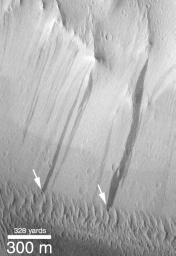
|
Dark Streaks Over-riding Inactive Dunes
- Click the image above for a larger view
- Full-Res JPEG (476 x 696) (51.6 kB)
- Full-Res TIFF (476 x 696) (250.9 kB)
Caption:
Not all sand dunes on Mars are active in the modern martian environment. This example from the Lycus Sulci (Olympus Mons "aureole") region shows a case where small windblown dunes at the base of a slope have been over-ridden by more recent dark streaks (arrows). The dark streaks are most likely caused by what geologists call mass wasting or mass movement (landslides and avalanches are mass movements). Dark slope streaks such as these are common in dustier regions of Mars, and they appear to result from movement of extremely dry dust or sand in an almost fluidlike manner down a slope. This movement disrupts the bright dust coating on the surface and thus appears darker than the surrounding terrain.
In this case, the dark slope streaks have moved up and over the dunes at the bottom of the slope, indicating that the process that moves sediment down the slope is more active (that is, it has occurred more recently and hence is more likely to occur) in the modern environment than is the movement of dunes and ripples at this location on Mars. The dunes, in fact, are probably mantled by dust. This October 1997 Mars Global Surveyor (MGS) Mars Orbiter Camera (MOC) picture is illuminated from the left and located near 31.6°N, 134.0°W.
Cataloging Keywords:
| Name | Value | Additional Values |
|---|---|---|
| Target | Mars | |
| System | ||
| Target Type | Planet | |
| Mission | Mars Global Surveyor (MGS) | |
| Instrument Host | Mars Global Surveyor | |
| Host Type | Orbiter | |
| Instrument | Mars Orbiter Camera (MOC) | |
| Detector | ||
| Extra Keywords | Dune, Dust, Grayscale, Mountain | |
| Acquisition Date | ||
| Release Date | 2000-05-05 | |
| Date in Caption | ||
| Image Credit | NASA/JPL/MSSS | |
| Source | photojournal.jpl.nasa.gov/catalog/PIA02357 | |
| Identifier | PIA02357 | |
